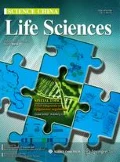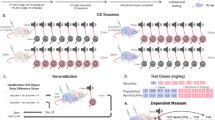Abstract
The reward-related effects of addictive drugs primarily act via the dopamine system, which also plays an important role in sensorimotor gating. The mesolimbic dopamine system is the common pathway of drug addiction and sensorimotor gating. However, the way in which addictive drugs affect sensorimotor gating is currently unclear. In previous studies, we examined the effects of morphine treatment on sensory gating in the hippocampus. The present study investigated the effects of morphine on sensorimotor gating in rats during chronic morphine treatment and withdrawal. Rats were examined during treatment with morphine for 10 successive days, followed by a withdrawal period. Acoustic startle responses to a single startle stimulus (115 dB SPL) and prepulse inhibition responses were recorded. The results showed that acoustic startle responses were attenuated during morphine treatment, but not during withdrawal. PPI was impaired in the last 2 morphine treatment days, but returned to a normal level during withdrawal.
Similar content being viewed by others
References
Koob G F, Bloom F E. Cellular and molecular mechanisms of drug dependence. Science, 1988, 242:715–723 1:CAS:528:DyaL1MXhsl2itA%3D%3D, 10.1126/science.2903550, 2903550
Spanagel R, Weiss F. The dopamine hypothesis of reward: past and current status. Trends Neurosci, 1999, 22:521–527 1:CAS:528:DyaK1MXmvVKhtrg%3D, 10.1016/S0166-2236(99)01447-2, 10529820
Wise R A. Drug-activation of brain reward pathways. Drug Alcohol Depend, 1998, 51:13–22 1:CAS:528:DyaK1cXks1OlsLs%3D, 10.1016/S0376-8716(98)00063-5, 9716927
Hoffman H S, Ison J R. Reflex modification in the domain of startle: I. Some empirical findings and their implications for how the nervous system processes sensory input. Psychol Rev, 1980, 87:175–189 1:STN:280:DyaL3c7ptVGqsw%3D%3D, 10.1037/0033-295X.87.2.175, 7375610
Ison J R, Hoffman H S. Reflex modification in the domain of startle: II. The anomalous history of a robust and ubiquitous phenomenon. Psychol Bull, 1983, 94:3–17 1:STN:280:DyaL2c%2Fhs1CmtQ%3D%3D, 10.1037/0033-2909.94.1.3, 6353464
Graham F K. The more or less startling effects of weak prestimulation. Psychophysiology, 1975, 12:238–248 1:STN:280:DyaE2M3hvVarsg%3D%3D, 10.1111/j.1469-8986.1975.tb01284.x, 1153628
Braff D, Stone C, Callaway E, et al. Prestimulus effects on human startle reflex in normals and schizophrenics. Psychophysiology, 1978, 15:339–343 1:STN:280:DyaE1M%2Fht12rtQ%3D%3D, 10.1111/j.1469-8986.1978.tb01390.x, 693742
Braff D L, Geyer M A. Sensorimotor gating and schizophrenia. Human and animal model studies. Arch Gen Psychiatry, 1990, 47:181–188 1:STN:280:DyaK3c7ks1yksQ%3D%3D, 2405807
Braff D L, Grillon C, Geyer M A. Gating and habituation of the startle reflex in schizophrenic patients. Arch Gen Psychiatry, 1992, 49:206–215 1:STN:280:DyaK383jtFKktA%3D%3D, 1567275
Swerdlow N R, Geyer M A, Braff D L. Neural circuit regulation of prepulse inhibition of startle in the rat: current knowledge and future challenges. Psychopharmacology (Berl), 2001, 156:194–215 1:CAS:528:DC%2BD3MXmtlCqtbs%3D, 10.1007/s002130100799
Acri J B, Morse D E, Popke E J, et al. Nicotine increases sensory gating measured as inhibition of the acoustic startle reflex in rats. Psychopharmacology (Berl), 1994, 114:369–374 1:CAS:528:DyaK2cXjtFGkt78%3D, 10.1007/BF02244861
Swerdlow N R, Caine S B, Geyer M A. Opiate-dopamine interactions in the neural substrates of acoustic startle gating in the rat. Prog Neuropsychopharmacol Biol Psychiatry, 1991, 15:415–426 1:CAS:528:DyaK3MXkvVGhs78%3D, 10.1016/0278-5846(91)90072-9, 1862221
Robinson T, Berridge K. The neural basis of drug craving: an incentive-sensitization theory of addiction. Brain Res Rev, 1993, 18:247–291 1:CAS:528:DyaK3sXlsFWnu78%3D, 10.1016/0165-0173(93)90013-P, 8401595
Zheng J, Yang Y, Tian S, et al. The dynamics of hippocampal sensory gating during the development of morphine dependence and withdrawal in rats. Neurosci Lett, 2005, 382:164–168 1:CAS:528:DC%2BD2MXks1Ggtbs%3D, 10.1016/j.neulet.2005.03.010, 15911142
Yang G, Liu X F, Liu N, et al. Dynamics of hippocampal sensory gating during the chronic morphine administration, withdrawal and re-exposure to morphine in rats. Acta Physiol Sin (in Chinese), 2007, 59:305–310 1:CAS:528:DC%2BD1cXos1ynu7k%3D
Zheng J, Yang Y, Tian S, et al. The dynamics of hippocampal sensory gating during the development of morphine dependence and withdrawal in rats. Neurosci Lett, 2005, 382:164–168 1:CAS:528:DC%2BD2MXks1Ggtbs%3D, 10.1016/j.neulet.2005.03.010, 15911142
Hubner C B, Koob G F. The ventral pallidum plays a role in mediating cocaine and heroin self-administration in the rat. Brain Res, 1990, 508:20–29 1:CAS:528:DyaK3cXhtlagtbw%3D, 10.1016/0006-8993(90)91112-T, 2337788
Koob G F. Drugs of abuse: anatomy, pharmacology and function of reward pathways. Trends Pharmacol Sci, 1992, 13:177–184 1:CAS:528:DyaK38XisVygsbc%3D, 10.1016/0165-6147(92)90060-J, 1604710
Koob G F. Neuroadaptive mechanisms of addiction: studies on the extended amygdale. Eur Neuropsychopharmacol, 2003, 13:442–452 1:CAS:528:DC%2BD3sXptVShsL8%3D, 10.1016/j.euroneuro.2003.08.005, 14636960
Hoffman D C, Donovan H. D1 and D2 dopamine receptor antagonists reverse prepulse inhibition deficits in an animal model of schizophrenia. Psychopharmacology, 1994, 115:447–453 1:CAS:528:DyaK2cXlvFGktL0%3D, 10.1007/BF02245567, 7871088
Mansbach R S, Brooks E W, Sanner M A, et al. Selective dopamine D4 receptor antagonists reverse apomorphine-induced blockade of prepulse inhibition. Psychopharmacology, 1998, 135:194–200 1:CAS:528:DyaK1cXptl2ktA%3D%3D, 10.1007/s002130050501, 9497025
Author information
Authors and Affiliations
Corresponding author
Additional information
Contributed equally to this work
Rights and permissions
About this article
Cite this article
Meng, Z., Zhou, D., Wang, J. et al. Chronic morphine treatment decreases acoustic startle response and prepulse inhibition in rats. Sci. China Life Sci. 53, 1356–1360 (2010). https://doi.org/10.1007/s11427-010-4077-2
Received:
Accepted:
Published:
Issue Date:
DOI: https://doi.org/10.1007/s11427-010-4077-2




